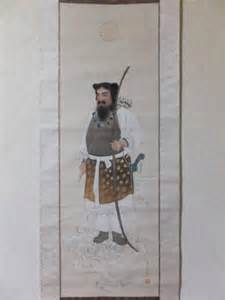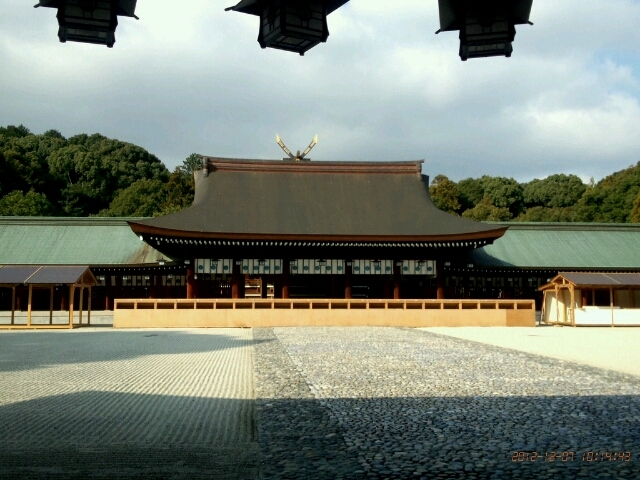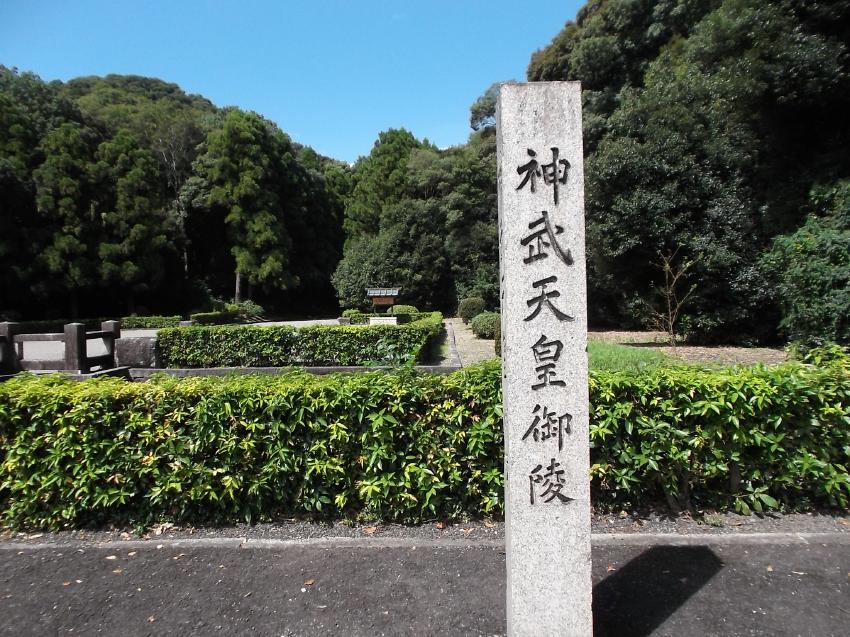Eldest Son’s Conspiracy
(Emperor Jimmu)
Emperor Jimmu passed away (The word “Kamuagaru” is only used for emperors of Japan.). His eldest son named Tagishimimi-no Mikoto (His mother is Ahirahime, to whom Emperor Jimmu had gotten married before he was enthroned.) got married to Empress of late Emperor Jimmu with the plan to make himself look like he was the legitimate successor. In those days, the marriage of this kind was not uncommon at all. Besides, Isukeyorihime was not his biological mother.
(Kashihara Jingu/Shrine: https://en.wikipedia.org/wiki/Kashihara_Shrine)
Just getting married to the late Emperor’s wife didn’t give him a good reason to succeed to the throne, however. Tagishimimi had a clear plan to kill all his half-brothers. Isukeyorihime, knowing his plan, was agonized and made a poem to tell them her husband’s vicious plan:
The clouds are building up from the Sai River.
The leaves in the Unebi Mountain are rustling hard.
The wind is rising.
She went on with another poem:
The Unebi Mountain looks calm with the clouds during the daytime.
But in the evening,
the leaves are making a big rustling sound.
The wind is coming near.
These poems of their mother informed them of his half-brother’s conspiracy. Three brothers were about to kill their own mother’s husband. Kamununakawa-no Mikoko, the youngest son of Isukeyorihime, suggested to his brother named Kamuyaimimi-no Mikoto that he should kill their step-father.
Kamuyaimimi was such a coward that he tried to kill Tagishimimi, only in vain. Then, Kamununakawa took away the weapon from his brother’s hands and successfully murdered his hateful half-brother and step father Tagishimimi. Due to his bravery, he was called “Takenunakawamimi-no Mikoto” from then on. “Take” in “Takenunakawamimi-no Mikoto” means “undaunted” or “intrepid.”
Now Kamuyaimimi-no Mikoto, though he is older than Takenunakawamimi, decided not to be enthroned, but he asked Takenunakawamimi-no Mikoto to succeed to the throne. He promised he would assist his brother from then on as a chief of official rituals.
Accordingly Takenunakawamimi-no Mikoto was enthroned as Emperor Suizei, the second Emperor of Japan.
(Emperor Suizei, Second Emperor of Japan)
The oldest brother named Hikoyai-no Mikoto became an ancestor of Umarata-no Muraji and Teshima-no Muraji. On the other hand, Kamuyaimimi-no Mikoto became an ancestor of Oomi-no Omi, Chiisakobe-no Muraji, Sakaibe-no Muraji, Hi-no Kimi, Ookida-no Kimi, Aso-no Kimi, Tsukushi-no Miyake-no Muraji, Sasakibe-no Omi, Sazakibe-no Miyatuko, Ohatsuse-no Miyatsuko, Tsuke-no Atai, Iyo-no Kumi-no Miyatsuko, Shinano-no Kuni-no Miyatsuko, Michinoku-no Iwaki-no Kuni-no Miyatsuko, Hitachi-no Naka-no Kuni-no, Nagasan-no Kuni-no Miyatsuko, Ise-no Funaki-no Atai, Owari-no Niwa-no Omi, and Shimada-no Omi.
You can see a lot of clan names like above as relatives to the Emperor when Kojiki was compiled.
Kamuyamato Iwarebiko-no Sumeramikoto (Emperor Jimmu) was one hundred thirty seven years old when he passed away. His tomb is located in the area called Kashi-no O, north of the Mountain Unebi.
(The sign says, “This is Emperor Jimmu’s Tomb.”)







